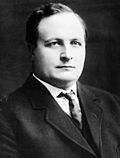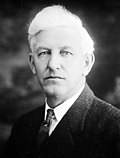Top Qs
Timeline
Chat
Perspective
List of governors of North Dakota
From Wikipedia, the free encyclopedia
Remove ads
The governor of North Dakota is the head of government of the U.S. state of North Dakota. The governor is the head of the executive branch of North Dakota's state government and is charged with enforcing state laws.

There have been 32 governors since North Dakota became a state, serving 33 distinct terms, with William Langer having been elected to multiple terms. The current officeholder is Republican Kelly Armstrong.
Remove ads
Governors
Summarize
Perspective
Dakota Territory was organized on March 2, 1861;[1] on November 2, 1889, it was split into the states of North Dakota and South Dakota.[2]
The Constitution of North Dakota originally provided for the election of a governor and lieutenant governor every two years, which was changed to four years in 1964.[3] A limit of two terms was added in 2023.[4] The governor and lieutenant governor are elected together on a ticket,[5] and should the office of governor become vacant, the lieutenant governor becomes governor.[6] The term of office begins on the December 15 following the election.[7]
Remove ads
See also
Notes
- Represented the Democratic-Independent Party
- Fancher was nominated by the Republican Party, but withdrew from the election due to health concerns.[34]
- Frazier was recalled and Nestos elected to replace him in a special election.
- Shafer instead ran unsuccessfully for the Republican nomination to the United States Senate.[59]
- Langer was removed from office following his conviction of felony conspiracy to defraud the federal government; he was later cleared.[62] He was convicted on June 17 and Lieutenant Governor Ole H. Olson immediately moved to take over, receiving the oath of office.[66] The Supreme Court ruled Langer was ineligible on July 17, and Olson formally took office on July 19.[67]
- The Supreme Court ruled that Moodie did not meet residency requirements to run for governor, and so removed him.[70]
- Langer instead ran unsuccessfully for the United States Senate.[62]
- Moses was instead elected to the United States Senate.[77]
- Aandahl was instead elected to the United States House of Representatives.[80]
- Davis instead ran unsuccessfully for the United States Senate.[86]
- Hoeven resigned, having been elected to the United States Senate.
Remove ads
References
External links
Wikiwand - on
Seamless Wikipedia browsing. On steroids.
Remove ads

































